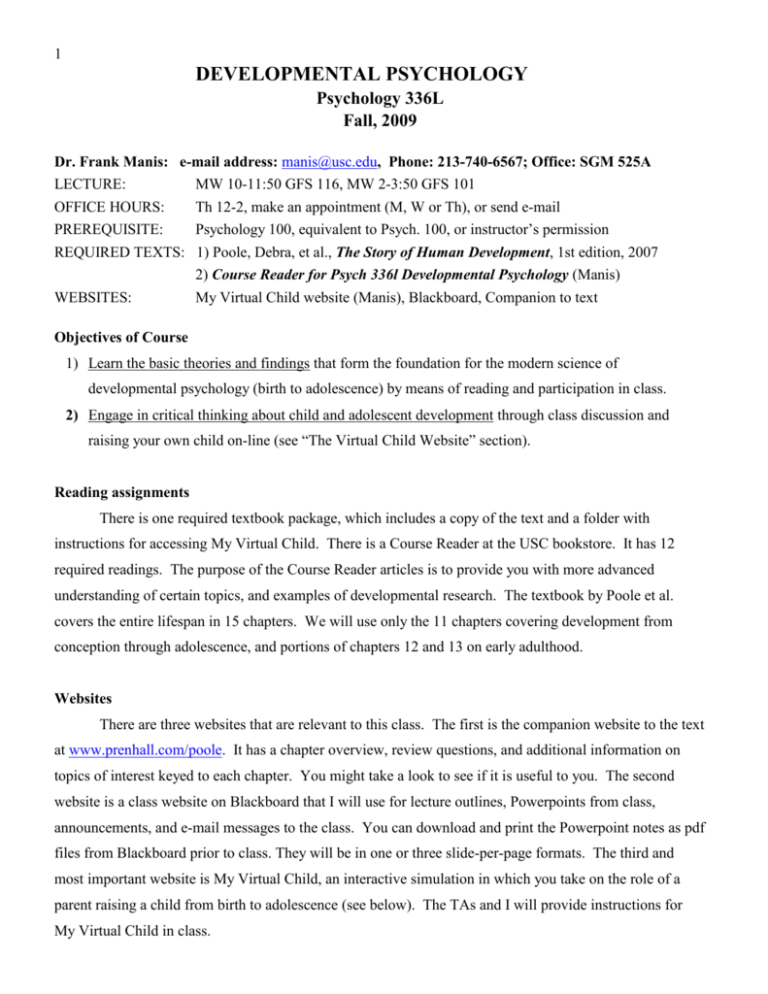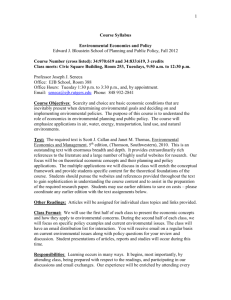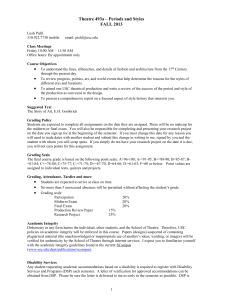Fall, 2009
advertisement

1 DEVELOPMENTAL PSYCHOLOGY Psychology 336L Fall, 2009 Dr. Frank Manis: e-mail address: manis@usc.edu, Phone: 213-740-6567; Office: SGM 525A LECTURE: MW 10-11:50 GFS 116, MW 2-3:50 GFS 101 OFFICE HOURS: Th 12-2, make an appointment (M, W or Th), or send e-mail PREREQUISITE: Psychology 100, equivalent to Psych. 100, or instructor’s permission REQUIRED TEXTS: 1) Poole, Debra, et al., The Story of Human Development, 1st edition, 2007 2) Course Reader for Psych 336l Developmental Psychology (Manis) WEBSITES: My Virtual Child website (Manis), Blackboard, Companion to text Objectives of Course 1) Learn the basic theories and findings that form the foundation for the modern science of developmental psychology (birth to adolescence) by means of reading and participation in class. 2) Engage in critical thinking about child and adolescent development through class discussion and raising your own child on-line (see “The Virtual Child Website” section). Reading assignments There is one required textbook package, which includes a copy of the text and a folder with instructions for accessing My Virtual Child. There is a Course Reader at the USC bookstore. It has 12 required readings. The purpose of the Course Reader articles is to provide you with more advanced understanding of certain topics, and examples of developmental research. The textbook by Poole et al. covers the entire lifespan in 15 chapters. We will use only the 11 chapters covering development from conception through adolescence, and portions of chapters 12 and 13 on early adulthood. Websites There are three websites that are relevant to this class. The first is the companion website to the text at www.prenhall.com/poole. It has a chapter overview, review questions, and additional information on topics of interest keyed to each chapter. You might take a look to see if it is useful to you. The second website is a class website on Blackboard that I will use for lecture outlines, Powerpoints from class, announcements, and e-mail messages to the class. You can download and print the Powerpoint notes as pdf files from Blackboard prior to class. They will be in one or three slide-per-page formats. The third and most important website is My Virtual Child, an interactive simulation in which you take on the role of a parent raising a child from birth to adolescence (see below). The TAs and I will provide instructions for My Virtual Child in class. 2 Exams There are 3 exams, consisting of two midterms and a final (non-cumulative). See the schedule for the content covered on each exam, the length and the format. Please note the dates for exams. Missing an exam without an excuse is grounds for receiving a “0” on that exam. Contact me as soon as possible if you cannot be there due to illness, participation in an athletic event, family or personal emergencies or religious observance. You need approval from me prior to missing an exam. I will arrange an in-office essay make-up exam to students with approved excuses. You can’t skip an exam and pro-rate the other two exams. I don’t like pro-rating because students miss out on learning the material. If you become ill or have an emergency shortly before the exam, you should leave a message on my answering machine (213-740-6567) or e-mail me (manis@usc.edu). Describe the illness or emergency to me briefly. I might need written documentation. If the illness or emergency was severe enough to prevent you from taking the exam, we will follow the procedure described above for a make-up essay exam. Exams consist of about 25% new material from lecture that is not found in the text or course reader or represents added details on topics found in the readings, 50% that is based on material covered in both class and readings, and 25% unique to the readings, comprising the most obvious points from the textbook and course reader that were not discussed in class. I will provide pointers in class to this material, study guide questions and an exam review. My Virtual Child Website I wrote the Virtual Child website to help students experience child development from a parent’s point of view. You and an imaginary partner will raise a “child” on an interactive website from birth to 18 years. You’ll write four 4-5-page papers (20 points each) analyzing your child’s development in the four periods of infancy, early childhood, middle childhood and adolescence. You’ll get a handout with scoring rubrics for the reports. Reports are turned in as hard copies. We deduct 2 points every full day a report is late, including weekend days, to a maximum of 10 points. Late papers can be turned in by 5 PM weekdays at the Psych main desk in SGM 501 and have it stamped that day (1 point off for a half-day late paper). I’ll explain more in class, but here are the basics. You log on and are told you have a new baby girl or boy. You get to name the child and make choices about how the child will look (hair, eye color and skin tone). You’ll fill out a brief questionnaire about yourself. Your responses will be used to construct a child who somewhat resembles you in terms of personality and cognitive ability profile. Each child shows typical developmental milestones, but also develops along a particular path according to his/her own unique “genetic” profile, the parenting choices you make, and “random” environmental events. We will discuss 3 your children in class, enabling you to see the variety in child development among the group, seek the advice of the other parents about a problem your child is having, or brag about your child (time-honored traditions). Why is this class listed as a lab class? We don’t have a separate lab meeting time because lab will be conducted during class. The purpose of the lab is to encourage hands-on learning. There are a variety of activities, labeled in the schedule as class exercise. Some of them involve your analysis and discussion of your virtual child in small groups in class. Some include viewing videotapes of children and observing and analyzing their behavior. Some activities require you to do an exercise in class that gets you thinking about child and adolescent issues, often in response to a video. Three of these activities are outside class: you’ll observe children at a day-care center, preschool and elementary school, and write short reports (8 points each). At present, the TAs and I are planning to have an in-class exercise or discussion every class. I am making them worth two points each. Sometimes the class activities will involve doing a short piece of work, but other times, simply being present and participating in the discussion will be enough to earn credit. We count 20 of these sessions. This means you are in effect allowed to miss up to 6 before losing credit. However, going to more than 20 sessions earns you bonus points (up to 12 points). Videos I use videos often to illustrate child behavior and promote discussion, and several will be used for class exercises. Others are simply extensions of the lecture, and you will need to take notes. Most are shorter videos (3-10 minutes). It is impossible to make all of the short videos available to watch outside class. If you miss class, get the Powerpoint lecture outline from the website. If you see from the lecture outline posted on Blackboard that a short video was shown, get notes about it from another student or see me during office hours for a recap. I will try to insert short videos into the Powerpoint presentation available on Blackboard, but I make no promises! Longer videos (30 minutes and up) are printed in italics in the schedule. These will be on 2-hour reserve at Leavey Library, indicated by an (L). Right now there are several longer videos in the schedule. If any are added, I will announce this in class and on Blackboard. Attendance and Participation in Lectures This is a highly interactive class with a lot of class activities, assignments, etc. This means that regular attendance, active note-taking and participation in the class are needed to get the most out of the course. I design lectures as clarifications and extensions of the reading assignments. This means there will always be new information in the lecture that is not in the readings, or that extends material in the readings. I enjoy answering your questions and hope you come to class ready to ask lots of questions. 4 In a typical lecture/discussion, I won’t define terms from the book. To get the most out of lectures I recommend skimming the reading assigned for the day, familiarizing yourself with all of the key terms and reading the Course Reader article(s) for the day. Print out the Powerpoint slides (if provided) and bring them to class, as they will often contain much needed graphics, definitions and quotes. If you miss class, you are responsible for obtaining missing information. A study buddy can help or you can borrow another student’s notes. Visit my office to go over portions of lectures or readings, get help studying for exams, or just talk about careers in psychology-related fields. The TAs are the main resource to provide feedback on Virtual Child reports and also can go over material from the readings with you. Summary of Assignments 1. Exam 1 (80 points) + Exam 2 (100 points) + Exam 3 (Final) (100 points) = 280 points 2. Virtual Child reports (4 @ 20 points each) – answer 5 questions from the handout = 80 points 3. Field Observation Reports (3 @ 8 points each) = 24 points 4. Class participation (26 @ 2 points, count 20) = 40 points 5. Bonus points – unused class participation points: up to 12 points available as bonus points Total = 424 points Grading scale Grading is based on total points accumulated. An ‘A’ is given for obtaining 93.3% of the total possible points (i.e., 396 points). The remaining cut-offs are A - (90%), B + (86.7%), B (83.3%), B- (80%), C + (77.7%), C (73.3%), C- (70%), D + (67.7%), D (63.3%), D – (60%), and F (below 60%). Note on Academic Integrity Students should follow all guidelines about plagiarizing and cheating given out by the University in the SCampus booklet, found at http://www.usc.edu/scampus. Violations will be punished according to USC rules. If you have questions about academic integrity, consult SCampus or two publications by the Office for Student Conduct, entitled, “Guide to Avoiding Plagiarism” and “Understanding and Avoiding Academic Dishonesty” (found at http://www.usc.edu/student-affairs/SJACS). They make clear what does and does not constitute plagiarism or cheating. Your TA will discuss Virtual Child report plagiarism. Note on disability accommodations Students requesting academic accommodations based on a disability are required to register with Disability Services and Programs (DSP) each semester. A letter of verification for approved accommodations can be obtained from DSP when adequate documentation is filed. Be sure the documentation is delivered to the Director of Disability Services as early in the year as possible. DSP is open Mon.-Fri. 8:30 – 5:00. The office is in Student Union 301; their phone number is (213) 740-0776. 5 TENTATIVE CLASS SCHEDULE (topics and assignments subject to change) I recommend that you check the schedule a week or more in advance so you can plan ahead. KEY to schedule: CR = Course Reader “Ch. 1, 2, etc.” = Poole et al. text (L) means a video is available at Leavey Library bold print indicates a class exercise or assignment due; bold italics indicates a class exercise VC = Virtual Child P1, P2, etc. = class participation recorded DATE TOPICS, ASSIGNMENTS, AND READINGS Aug 24 Course overview (syllabus); why we study development; questions of interest to you. Aug 26 Theories of development (Ch. 1); exercise (P1): which theory is closest to your own? Aug 31 Theories of Development, cont. (CR # 1, “Governments, Grade Schools, and Grocery Stores”); exercise (P2): what was your ecology? Sept 2 Genes, environment & the brain (Ch. 2, 45-66; CR #2, “Environmental and Behavioral Influences on Gene Activity”); exercise (P3): thinking about genetic influences; hand out study guide for EXAM 1 Sept 7 LABOR DAY Sept 9 Studying Genes, Env. & Culture (Ch. 2, pp. 66-83; CR #3, 4 – two short articles on geneenvironment relations); exercise (P4): Virtual Child demo Sept 14 Prenatal Development (Ch 3, pp. 85-96) - exercise (P5): questions on video In the Womb (90 min.) (L); start VC (questionnaire through birth of the child) outside of class Sept 16 Problems in Prenatal Development, Birth Process and Birth Complications (Ch. 3, 96125, CR #5, “Garden Island”); longitudinal studies of prenatal influences; exercise (P6): questions on video, The Baby’s Brain (35 min.) (L); developmental outcomes for preemies, risk and resilience; review for Exam 1 (Poole, Ch. 1-4, CR # 1-5) Sept 21 EXAM 1 (70 multiple choice, 5 short answers = 80 points); EID AL FITR Sept 23 Profile of the First 3 Years – Motor, Brain and Percep. Development (Ch. 4, pp. 127-143; CR #6, “The Improvising Infant”); exercise (P7) on video, The Baby’s World (30 min.) (L); hand out day-care obs. worksheet (8 points) due Oct 5, & study guide for EXAM 2 Sept 28 Profile of the First Three Years – Cognitive Development (Ch. 4, pp. 143-155); home videos of Piaget stages; exercise (P8): analyzing a young child’s language; YOM KIPPUR Sept 30 Profile of the First Three Years – Emotional and Social Development (Ch. 4, pp. 156-165; Video, First Feelings (L); temperament and attachment; VC 3-12 months discussion (P9) Oct 5 Pathways through the First Three Years (Ch. 5, pp. 171-201); raising infants & 6 toddlers; day-care observation worksheet due (8 points); VC 18-30 months discussion (P10) Oct 7 Pathways through the First Three Years (Ch. 5, pp. 202-211; CR #7 Romanian orphans); early experience; exercise (P11): infant stimulation videos; pass out preschool field trip worksheet (due Oct 21) Oct 12 Profile of Early Childhood – Motor, Brain & Perceptual Dev (Ch. 6, pp. 213-224); exercise (P12): analyzing books for young children; VC Report 1 (age 0 to 2 ½ years) due (20 points); Oct 14 Profile of Early Childhood – Cognitive Development (Ch. 6, pp. 224-239; 249-252); child witnesses; exercise (P13): videos on dual representation, theory of mind, grammar Oct 19 Profile of Early Childhood – Emotional and Social Development (Ch. 6, pp. 239-249); class exercise: observing children’s play and social behavior; VC age 3 years discussion (P14) Oct 21 Pathways through Early Childhood (Ch. 7, pp. 257-278, CR #8 “Personality types”) – health, personality types, developmental psychopathology; autism video; VC age 4-5 discussion (P15); preschool field trip worksheet due (8 points) Oct 26 Pathways through Early Childhood (Ch. 7, pp. 279-299) – gender, culture and parenting style; preschool and early intervention; media influences; exercise (P16) Sesame Street videos; VC Report 2 (age 3-5) due (20 points) Oct 28 Health and Phys. Development in Middle Childhood (THIS IS NOT ON EXAM 2) (Ch. 8, 301-306; Ch. 9, 347-353); discuss nutrition, sleep, physical activity & sports; exercise (P17): discuss obesity; review for Exam 2 (Poole Ch. 4-7, CR # 6-8) Nov 2 EXAM 2 (80 multiple choice, 10 short answer = 100 points); pass out middle childhood field observation worksheet (due Nov 11) Nov 4 Brain & Cogn. Development in Middle Childhood (Ch. 8, pp 306-321); video: The Child’s Brain, part 2, 15 min. (L) - dyslexia and other learning disabilities; Piaget’s theory of middle childhood; information processing theory; strategy development; VC age 6 discussion (P18); study guide for Exam 3 handed out. Nov 9 Schooling, Intelligence and Intelligence Tests (Ch. 8, 321-324; Ch. 9, 366383; CR # 9 “Multiple Intelligences”); exercise (P19): multiple intelligences; Is intelligence increasing & why? Heredity and environment in IQ testing. Nov 11 Social and Emot. Dev. in Middle Childhood (Ch. 8, pp. 324-343; CR #10, GeneEnvironment interaction: shyness); video: The In Crowd, 30 min. (L); aggression, bullying; VC age 8-10 discussion (P20); middle childhood field obs. worksheet due (8 points) Nov 16 Family & Peer Influences in Middle Childhood (Ch. 9, pp. 353-365, 384-386; CR # 11-13, 7 Harris, Maccoby & Cowan & Cowan chapters) – exercise (P21): Do parents matter? Discuss role of parents, peers & society in socioemotional dev.; VC Report 3 (age 6-10) due (20 pts) Nov 18 Profile of Adolescence & Early Adulthood (Poole Ch. 10, pp. 389-403, Ch. 12, p. 486); puberty & development; development of the brain through the mid-20’s; exercise (P22) on video, The Teenage Brain, 41 minutes (L). Nov 23 Profile of Adol. & Early Adulthood (Poole Ch. 10, pp. 403-411, Ch. 12, pp. 488496); cognitive development; decision making; information processing; VC age 12-14 discussion (P23) Nov 25 Profile of Adolescence & Early Adulthood (Poole Ch. 10, pp. 412-427, Ch. 12, pp. 497498, 507-513); identity crisis; relationships, exercise (P24): moral development in teens Nov 26-28 THANKSGIVING HOLIDAY Nov 30 Pathways through Adolescence & Early Adulthood (Poole Ch. 11, pp. 433-448); schooling, parenting, teen employment; sex and drugs; VC age 16-18 years discussion (P25) Dec 2 Pathways through Adol. & Early Adulthood (Poole Ch. 11, pp. 449-473; Ch. 13, 525-526, 532-535); delinquency & eating disorders; building a resilient teen; exercise (P26): “What matters in development and why?”; VC Report 4 (age 11-18) due (20 points); course evaluations Dec 4 Optional VC Bonus Report is due: up to 3 questions selected from the “Bonus Questions” on the VC handout. Combines with extra class exercise points to total no more than 12 bonus points (e.g., answer 2 questions for 8 points + 4 points for extra class exercises) Dec 9 Review for Exam 3 (Final) - Poole Ch. 8-11, assigned portions of Ch. 12 and 13, CR #9-12, Dec 11 or 14 FINAL EXAM (Exam 3: 80 multiple choice, 10 short answers = 100 points) Final exam schedule for MW 10-11:50 section: Dec 14 (8-10 AM) Final exam schedule for MW 2-3:50 section: Dec 11 (2-4 PM)





